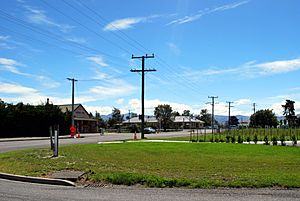Rotherham, New Zealand facts for kids
Quick facts for kids
Rotherham
|
|
|---|---|
|
town
|
|

George Street, Rotherham's main street
|
|
| Country | New Zealand |
| Region | Canterbury |
| Territorial authority | Hurunui District |
| Ward | West Ward |
| Electorates |
|
| Area | |
| • Total | 0.56 km2 (0.22 sq mi) |
| Population
(June 2023)
|
|
| • Total | 150 |
| • Density | 268/km2 (694/sq mi) |
| Time zone | UTC+12 (New Zealand Standard Time) |
| • Summer (DST) | UTC+13 (New Zealand Daylight Time) |
| Postcode |
7379
|
Rotherham is a small village in New Zealand. It's located in the Canterbury area, on the South Island. You can find it in the Hurunui District.
Rotherham is situated between the towns of Culverden and Waiau. It lies along the Inland Kaikōura Road. The village is also close to the south bank of the Waiau Uwha River. This river is a popular spot for trout and salmon fishing.
Contents
Rotherham's Railway History
For a long time, people wanted a railway line to reach Rotherham. On February 8, 1886, a railway line opened to Culverden. However, building stopped there for a while. There was a lot of discussion about where the railway should go next.
Building the Waiau Branch Line
Some plans suggested the railway should pass through Rotherham. Finally, in 1914, work began to extend the line. This extension would go to Waiau, passing through Rotherham. The new section of the railway opened on December 15, 1919. This line became known as the Waiau Branch.
Rotherham Station
The railway station in Rotherham was quite large. It was bigger than most other small-town stations in New Zealand. This might have been because some people thought the railway would end in Rotherham. The station also had special areas for farm animals (stockyards) and a building for goods. The stockyards were removed in 1970. The goods shed was sold and moved by July 1975.
The railway line itself closed on January 15, 1978. The station building stayed in its original spot. A local farmer bought it to use for their farm.
The Inland Kaikōura Road
The Inland Kaikōura Road used to be called New Zealand State Highway 70. However, it stopped being a state highway in 2004.
People and Population
Rotherham is a rural settlement. This means it's a small community in the countryside. It covers an area of about 0.56 square kilometers.
In 2018, Rotherham had a population of 144 people. This was an increase of 27 people since 2013. It was also 42 more people than in 2006.
There were 54 households in the village. There were more males (87) than females (57). The average age of people in Rotherham was 42.6 years old. About 33 people (22.9%) were under 15 years old. Also, 24 people (16.7%) were 65 or older.
Most people in Rotherham are of European descent (93.8%). Some people also identify as Māori (14.6%). A smaller number are Pasifika (2.1%) or Asian (6.2%). People can identify with more than one ethnicity.
When asked about religion, most people (54.2%) said they had no religion. About 27.1% were Christian. A small number were Hindu (2.1%) or had other religions (2.1%).
Education in Rotherham
Rotherham School is a primary school in the village. It teaches students from Year 1 to Year 6. It is a co-educational school, meaning both boys and girls attend.


